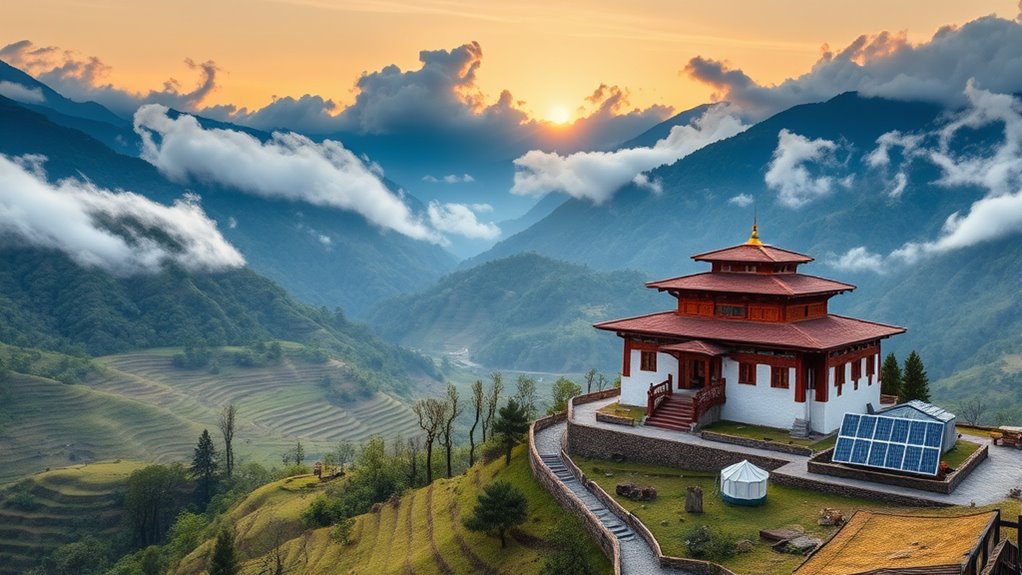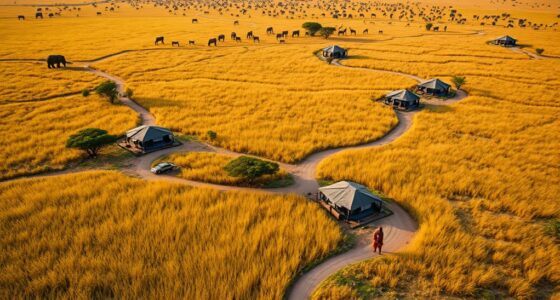Bhutan’s high-value, low-impact tourism policy focuses on attracting fewer visitors who spend more, helping protect its culture and environment. It limits tourist numbers through quotas and requires bookings with licensed operators. This approach boosts local economies, supports cultural preservation, and minimizes ecological damage. If you want to understand how Bhutan balances tourism growth with sustainability and what lessons it offers, there’s more to discover about this innovative model.
Key Takeaways
- Bhutan’s tourism policy emphasizes quality over quantity, limiting visitor numbers to protect culture and environment.
- It requires tourists to book through licensed operators, controlling access via a daily fee and permit system.
- The focus is on authentic, mindful experiences that respect local traditions and promote sustainable development.
- The policy aims to minimize ecological impact by encouraging eco-tourism and responsible travel practices.
- It balances economic growth with cultural and environmental preservation, serving as a model for sustainable tourism.
The Principles Behind Bhutan’s Tourism Approach

Bhutan’s tourism approach is rooted in the principle of prioritizing quality over quantity, guaranteeing that visitors experience the country’s culture and natural beauty without overwhelming it. This strategy promotes sustainable development, balancing economic growth with environmental preservation. By limiting visitor numbers, Bhutan safeguards its fragile ecosystems and reduces environmental impact, fostering a responsible tourism industry. Cultural integrity is central to this approach; you’ll find that traditions, customs, and local lifestyles are respected and preserved. The government encourages authentic experiences that deepen your understanding of Bhutanese heritage while preventing commercialization. This careful balance ensures that tourism benefits local communities, maintains the country’s unique identity, and preserves its pristine landscapes for future generations. It’s a thoughtful, respectful way to explore Bhutan’s rich cultural and natural treasures, emphasizing low-impact tourism as a core principle.
How the Policy Limits Tourist Numbers

Because maintaining the country’s delicate environment and cultural integrity is a top priority, Bhutan enforces strict limits on the number of tourists allowed each year. They do this through a tourist cap, which sets a maximum visitor quota annually. This quota guarantees that tourism remains sustainable and doesn’t overwhelm local resources or disrupt cultural practices. To obtain a permit, travelers must book through licensed tour operators who manage the visitor quota carefully. The government’s approach prevents mass tourism and preserves Bhutan’s unique identity. By controlling the number of visitors, Bhutan can maintain high-quality experiences while protecting its environment. This strategy ensures tourism benefits locals without compromising the country’s core values or ecological health. Implementing a clear financial settlement time limit helps streamline processes and uphold these conservation efforts.
The Economic Impact of High-Value Tourism

High-value tourism can boost Bhutan’s revenue profoundly while keeping visitor numbers manageable. It also encourages economic diversification by supporting various local businesses and industries. As you explore this approach, you’ll see how it helps create sustainable growth and benefits communities across the country. Incorporating mindfulness practices into tourism initiatives can further enhance visitor experiences and promote positive cultural exchanges.
Revenue Generation Potential
High-value tourism offers a promising avenue for generating substantial revenue while minimizing environmental and cultural impacts. By attracting fewer tourists but with higher spending power, Bhutan can greatly boost tourism revenue. This targeted approach encourages visitors to invest more in accommodations, guided tours, and local crafts, directly contributing to economic growth. The high spending per visitor helps create a steady income stream for local communities and government revenues. Furthermore, this model reduces the strain on natural resources and cultural sites, ensuring sustainable development. As a result, Bhutan can maximize its economic benefits without compromising its environmental and cultural integrity. Incorporating responsible tourism principles further supports long-term sustainability and community well-being. The potential for increased tourism revenue under this policy makes it a strategic choice for fostering long-term economic sustainability.
Economic Diversification Benefits
By attracting affluent travelers, Bhutan’s high-value tourism policy can considerably diversify its economy beyond traditional sectors. This shift promotes sustainable development by reducing reliance on agriculture and forestry, creating new income streams. The influx of high-end tourists boosts employment opportunities and fosters innovation across sectors. As a result, Bhutan builds economic resilience, making its economy less vulnerable to sector-specific shocks. Here’s how the diversification benefits play out:
| Sector | Benefits | Impact on Resilience |
|---|---|---|
| Hospitality & Services | Increased revenue, jobs | Strengthens economic stability |
| Cultural Tourism | Preservation of heritage | Enhances local engagement |
| Eco-Tourism | Sustainable income sources | Promotes sustainable growth |
| Art & Handicrafts | Market expansion, exports | Diversifies income streams |
| Infrastructure Development | Better connectivity | Bolsters long-term growth |
Local Business Growth
As Bhutan attracts more affluent tourists, local businesses experience increased demand for luxury accommodations, fine dining, and specialized services. This surge encourages local entrepreneurship, inspiring residents to develop innovative businesses that cater to high-end visitors. Artisanal crafts, such as handmade textiles, jewelry, and souvenirs, see a boost as tourists seek authentic, locally-made products. These opportunities motivate artisans and entrepreneurs to refine their skills and expand their offerings. The growth of small businesses not only creates jobs but also fosters a sense of pride in Bhutan’s cultural heritage. By supporting local entrepreneurship and artisanal crafts, high-value tourism helps diversify the economy while preserving traditional skills. This sustainable approach guarantees that the benefits of tourism reach grassroots levels, strengthening community resilience. Additionally, promoting local crafts enhances the unique cultural identity that appeals to high-end travelers.
Cultural Preservation Through Selective Tourism

Selective tourism in Bhutan actively supports the preservation of its rich cultural heritage by attracting visitors who respect and appreciate local traditions. By focusing on high-value travelers, the country ensures that visitors seek authentic experiences, helping to maintain cultural authenticity. You’ll experience traditional festivals that showcase Bhutan’s unique customs, art, and spiritual practices in their purest form. This targeted approach discourages mass tourism, which can dilute cultural significance. Instead, it encourages meaningful engagement with local communities, allowing their traditions to thrive. As a visitor, your appreciation for these customs helps reinforce their importance, ensuring they are preserved for future generations. Bhutan’s strategy ensures that tourism enhances, rather than erodes, the nation’s cultural identity. Understanding cultural preservation is essential for appreciating the importance of this selective approach.
Environmental Benefits of the Low-Impact Strategy

By choosing a low-impact tourism approach, you help preserve Bhutan’s stunning natural landscapes and prevent overdevelopment. This strategy also minimizes your ecological footprint, ensuring minimal disruption to the environment. Additionally, it supports biodiversity conservation, allowing unique species to thrive undisturbed. Embracing sustainable practices promotes environmental preservation and long-term ecological health.
Preserves Natural Landscapes
Bhutan’s high-value, low-impact tourism policy plays a crucial role in preserving its natural landscapes. By promoting eco tourism initiatives, you help reduce the environmental pressure on fragile ecosystems. These initiatives encourage responsible travel that minimizes harm to forests, mountains, and wildlife. Community engagement is central to this approach, empowering local residents to protect their environment and manage tourism sustainably. When you participate in community-led activities, you support conservation efforts directly and ensure that natural areas remain pristine. The policy discourages mass tourism, preventing overdevelopment and habitat destruction. As a result, Bhutan maintains its breathtaking landscapes for future generations, showcasing a model where tourism benefits both the environment and local communities without compromising natural beauty. Incorporating preppy dog names that reflect the country’s cultural heritage can also foster a deeper appreciation for local traditions and natural beauty.
Reduces Ecological Footprint
Implementing a high-value, low-impact tourism model considerably cuts down the ecological footprint of visitors. By promoting eco-friendly initiatives, Bhutan minimizes waste and conserves resources, ensuring tourism activities leave minimal environmental traces. These initiatives include waste management programs, renewable energy use, and sustainable transportation options that reduce carbon emissions. Community engagement plays a crucial role, as local residents actively participate in sustainable practices, fostering a collective effort to protect the environment. This approach encourages tourists to respect local ecosystems and adopt responsible behaviors. As a result, Bhutan’s tourism strategy effectively lowers environmental impacts, preserves natural resources, and promotes long-term ecological health. Maximize Space and Organization Your participation in this model helps maintain the country’s pristine landscapes while supporting sustainable development.
Supports Biodiversity Conservation
Since low-impact tourism minimizes environmental disturbance, it directly benefits biodiversity conservation in Bhutan. By promoting eco-friendly practices, this strategy helps protect delicate ecosystems and wildlife habitats. You contribute to wildlife protection by visiting responsibly and supporting conservation efforts. This approach ensures that Bhutan’s rich biodiversity remains intact for future generations. Your visit supports initiatives that preserve rare species and fragile environments. Here’s how low-impact tourism fosters biodiversity: Remote Hackathons can be used to develop innovative solutions for conservation challenges, engaging a global community of experts and enthusiasts.
Challenges and Criticisms of the Policy

Despite its noble intentions, Bhutan’s high-value, low-impact tourism policy faces significant challenges and criticisms. Overtourism concerns persist, as restricting visitor numbers can lead to increased pressure on the existing infrastructure and local communities. Some argue that limiting tourist numbers may not fully prevent environmental degradation or cultural dilution. Additionally, critics point out that the policy may inadvertently deepen economic inequality. Wealthier travelers can afford the high costs, benefiting from exclusive experiences, while local residents and small businesses might not see proportional economic gains. This creates a divide where tourism’s benefits are unevenly distributed. These challenges highlight the difficulty of balancing sustainable tourism goals with economic and social realities, raising questions about the policy’s long-term effectiveness and fairness.
Lessons and Inspirations for Global Tourism

Bhutan’s approach to sustainable tourism offers valuable lessons for the world, demonstrating that prioritizing environmental integrity and cultural preservation can shape a more responsible travel industry. By limiting mass tourism and focusing on high-value visitors, Bhutan reduces environmental degradation and maintains its unique identity. This model encourages other destinations to rethink growth strategies, emphasizing quality over quantity. You can take inspiration from Bhutan’s policies by:
Bhutan’s sustainable tourism model highlights the importance of environmental care and cultural preservation.
- Implementing visitor caps to avoid overcrowding
- Promoting eco-friendly travel practices
- Supporting local communities and cultures
- Valuing long-term sustainability over short-term profits
These steps help combat the negative impacts of mass tourism, protect natural resources, and ensure tourism benefits both visitors and hosts. Adopting such principles can lead to a more balanced, resilient global tourism industry.
Frequently Asked Questions
How Does Bhutan Measure the Success of Its Tourism Policy?
You can see Bhutan measures its tourism success through several indicators. They track environmental impact by monitoring natural resource use and ecological footprints. Cultural preservation is assessed through visitor engagement with local traditions and community feedback. If these areas improve or stay balanced, it shows the policy works. Overall, they prioritize sustainability, ensuring tourism benefits the environment and culture without overburdening either, reflecting true success in their approach.
What Specific Criteria Determine a High-Value Tourist in Bhutan?
You determine a high-value tourist in Bhutan by considering if they’re luxury travelers who seek exclusive experiences or cultural enthusiasts enthusiastic to explore Bhutan’s traditions. These visitors typically respect local customs, stay in eco-friendly accommodations, and spend more per visit, supporting sustainable tourism. The focus is on quality over quantity, ensuring they contribute positively without overwhelming the environment or local communities.
How Are Local Communities Involved in Tourism Planning?
You’re likely curious about how local communities get involved in tourism planning. In Bhutan, community participation is key, enabling locals to share their insights and needs. The government promotes local empowerment by including community representatives in decision-making processes. This ensures tourism benefits are distributed fairly, respects local cultures, and minimizes environmental impact, aligning with Bhutan’s sustainable tourism goals. Your involvement helps create a more authentic, responsible tourism experience for everyone.
What Alternative Tourism Models Could Bhutan Consider in the Future?
Thinking about future tourism models, you could consider creative concepts like community-centered eco-tourism development. This approach promotes cultural immersion, allowing visitors to deeply engage with local traditions, while minimizing environmental impact. By embracing eco-tourism development, Bhutan can build sustainable bonds between travelers and locals, fostering authentic experiences. Such models prioritize preservation of culture and nature, ensuring tourism thrives without threatening the very essence that makes Bhutan unique.
How Does Bhutan Address Potential Economic Downsides From Limited Tourism?
You can see that Bhutan addresses potential economic downsides by prioritizing sustainable development, ensuring tourism benefits local communities without harming the environment. They focus on economic diversification, encouraging industries beyond tourism like agriculture and handicrafts. By controlling visitor numbers and maintaining high-value tourism, Bhutan balances economic growth with preservation, reducing reliance on tourism alone. This approach helps secure long-term stability, allowing the economy to thrive while protecting cultural and natural resources.
Conclusion
By embracing Bhutan’s high-value, low-impact tourism model, you see a path where preserving culture and nature outshine mere numbers. It’s a bold reminder that quality truly beats quantity, and that responsible travel can protect treasures worth more than gold. Will you choose to follow this example, forging a future where tourism enriches rather than exhausts? Remember, in protecting Bhutan’s essence, you hold the power to inspire a global shift toward sustainable exploration.










